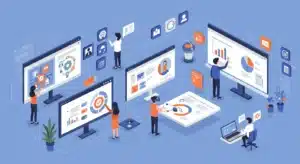
Visual Aid Ideas That Make Complex Topics Easy to Understand
Visual aids play a crucial role in simplifying complex topics, making them more accessible and engaging for audiences. Whether in a corporate setting, educational environment, or public speaking scenario, the right visual aids can transform a presentation from a monotonous monologue into an interactive dialogue. This article explores various visual aid ideas that can enhance understanding and retention, ensuring that your audience remains engaged and informed.
The Power of Visual Aids
Visual aids serve as a bridge between the presenter and the audience, allowing for a clearer understanding of intricate concepts. They can take many forms, including slides, infographics, videos, and interactive elements. The key is to choose the right type of visual aid that complements the content being presented.
Incorporating visual elements can help break down information into digestible pieces, making it easier for the audience to follow along. For example, a complex data set can be transformed into a simple chart or graph, highlighting key trends and insights. This not only aids comprehension but also keeps the audience engaged. Additionally, visual aids can cater to various learning styles, accommodating visual learners who may struggle with text-heavy presentations. By appealing to different senses, presenters can foster a more inclusive environment that encourages participation and interaction.
Types of Visual Aids
There are several types of visual aids that can be utilized to enhance presentations. Each type has its unique advantages and can be tailored to fit the specific needs of the topic at hand.
1. Slides and Presentations
Slides are perhaps the most common form of visual aid. They allow presenters to showcase key points, images, and data in a structured format. To maximize their effectiveness, slides should be visually appealing and not overloaded with text. Utilizing bullet points, images, and charts can help convey information more effectively.
Moreover, incorporating animations or transitions can add a dynamic element to the presentation, capturing the audience’s attention. However, it is essential to strike a balance; overusing animations can distract from the core message. Presenters should also consider the pacing of their slides, ensuring that each one is given enough time for the audience to absorb the information before moving on to the next point. This thoughtful approach can enhance retention and understanding.
2. Infographics
Infographics are powerful tools for summarizing complex information in a visually engaging manner. They combine text, images, and data to tell a story, making it easier for the audience to grasp the main ideas. Infographics are particularly effective for presenting statistics, processes, or comparisons, as they can visually represent relationships and trends.
When creating infographics, it is crucial to keep the design clean and uncluttered. Using a consistent color scheme and font style can enhance readability and ensure that the information is easily digestible. Furthermore, infographics can be shared easily across social media platforms, allowing the information to reach a wider audience beyond the initial presentation. This can serve as an excellent follow-up tool, reinforcing the key messages and encouraging further discussion among viewers.
3. Videos
Videos can bring topics to life, providing a dynamic way to engage the audience. They can be used to illustrate complex processes, showcase testimonials, or present case studies. A well-produced video can evoke emotions and create a connection with the audience, making the content more relatable.
When incorporating videos, it is essential to ensure that they are relevant to the topic and not overly long. A concise video that complements the presentation can enhance understanding and retention. Additionally, including captions or subtitles can make videos more accessible to a wider audience, including those who may have hearing impairments or those who prefer to watch without sound. This attention to accessibility not only broadens the reach of the content but also demonstrates a commitment to inclusivity in communication.
Interactive Visual Aids
In today’s digital age, interactive visual aids have become increasingly popular. They allow audiences to engage with the content actively, fostering a two-way conversation rather than a one-sided presentation. This approach can significantly enhance understanding and retention. By utilizing various forms of media, such as videos, infographics, and animations, presenters can cater to different learning styles, ensuring that the content resonates with a broader audience.
Using Technology to Engage
Technology has opened up new avenues for audience engagement. Platforms that facilitate real-time interaction, such as SMS-based tools, can transform a traditional presentation into a dynamic experience. For instance, audience members can ask questions via text, and presenters can respond instantly using AI-powered Q&A features. This immediacy not only enriches the dialogue but also fosters a sense of community among participants, as they realize their contributions are valued and acknowledged.
This method not only encourages participation but also ensures that no questions go unanswered. It allows presenters to capture valuable feedback and insights, turning engagement into actionable business opportunities. Furthermore, the integration of analytics tools can provide presenters with data on audience engagement levels, helping them refine their strategies for future presentations and better understand their audience’s needs.
4. Live Polling
Live polling is an excellent way to gauge audience understanding and opinions in real-time. By integrating polling tools into presentations, presenters can ask questions and receive instant feedback. This not only makes the audience feel involved but also provides valuable insights into their perspectives. The results of these polls can be displayed immediately, sparking discussions and prompting further questions, which can lead to deeper exploration of the topic at hand.
Moreover, live polling can help tailor the presentation on the fly, addressing areas where the audience may need more clarification. This adaptability can significantly enhance the overall effectiveness of the presentation. Additionally, the data collected from live polls can be utilized in follow-up communications, allowing presenters to address any lingering questions or concerns and reinforce key messages after the event.
5. Interactive Quizzes
Quizzes can be a fun and engaging way to reinforce learning. By incorporating interactive quizzes into the presentation, presenters can assess audience comprehension while keeping them entertained. This approach encourages participation and can lead to a more memorable learning experience. Quizzes can also serve as a break from the traditional lecture format, allowing participants to refresh their minds and re-engage with the material.
Quizzes can be designed to align with key points in the presentation, allowing presenters to revisit essential concepts and ensure that the audience retains the information shared. Moreover, incorporating elements like timed challenges or team-based competitions can further enhance engagement, as participants rally together to achieve a common goal, fostering collaboration and teamwork.
6. Gamification
Gamification involves applying game design elements to non-game contexts to enhance engagement. By integrating gamified elements into presentations, such as points, badges, or leaderboards, presenters can motivate the audience to participate actively. This strategy taps into the natural human desire for achievement and recognition, making the learning process more enjoyable and effective.
This approach can make complex topics more approachable and enjoyable, fostering a sense of competition and camaraderie among participants. Gamification can also lead to improved retention, as audiences are more likely to remember information when they have had a positive, interactive experience. Furthermore, by providing rewards or incentives for participation, presenters can create a more vibrant atmosphere that encourages ongoing engagement and enthusiasm throughout the presentation.
Enhancing Clarity with Visuals
Visual aids should not only engage but also clarify complex topics. The goal is to simplify information without oversimplifying it. Here are some strategies to enhance clarity through visuals.
Utilizing Color and Contrast
Color plays a vital role in visual communication. Using contrasting colors can help highlight important information and guide the audience’s attention. For example, using a bright color for key points against a neutral background can make them stand out and easier to remember.
However, it is important to use colors judiciously. Too many colors can create visual clutter and distract from the main message. A cohesive color palette that aligns with the presentation’s theme can enhance overall aesthetics and comprehension.
7. Consistent Layout
Maintaining a consistent layout throughout the presentation can help the audience follow along more easily. This includes using the same font styles, sizes, and colors for headings and body text. A uniform layout creates a sense of cohesion and professionalism, making it easier for the audience to focus on the content.
Additionally, using whitespace effectively can prevent slides from appearing overcrowded. Adequate spacing between elements allows the audience to process information without feeling overwhelmed.
8. Clear Typography
Typography is another critical aspect of visual communication. Choosing clear, legible fonts can significantly impact how easily the audience can read and comprehend the information presented. Sans-serif fonts are often preferred for digital presentations due to their clarity on screens.
Moreover, varying font sizes for headings and body text can help establish a visual hierarchy, guiding the audience’s attention to the most important points. Ensuring that text is large enough to be read from a distance is also essential, especially in larger venues.
9. Visual Metaphors
Visual metaphors can be powerful tools for simplifying complex ideas. By using familiar images or symbols to represent abstract concepts, presenters can create relatable connections for the audience. For instance, comparing a business strategy to a journey can help illustrate the steps involved in achieving a goal.
Using metaphors can make the content more memorable, as audiences are more likely to recall information that resonates with their experiences and understanding.
Feedback and Improvement
Gathering feedback is vital for improving future presentations. Understanding how audiences perceive visual aids can provide valuable insights into what works and what doesn’t. Here are some strategies for collecting feedback effectively.

Post-Presentation Surveys
Post-presentation surveys can be an excellent way to gauge audience satisfaction and gather constructive feedback. By asking specific questions about the effectiveness of visual aids, presenters can identify areas for improvement.
Surveys can be conducted through various platforms, allowing for anonymity and encouraging honest responses. This feedback can inform future presentations, helping presenters refine their approach and enhance audience engagement.
10. Audience Engagement Metrics
Utilizing audience engagement metrics can provide quantitative data on how well visual aids resonate with the audience. Tools that track engagement levels, such as conversation volume and participation rates, can help presenters assess the effectiveness of their visual strategies.
By analyzing this data, presenters can identify trends and patterns, allowing them to tailor future presentations to better meet audience needs and preferences.
11. Peer Reviews
Seeking feedback from colleagues or peers can provide valuable insights into the effectiveness of visual aids. Peer reviews can offer a fresh perspective and highlight areas that may need improvement.
Collaborating with others can also lead to new ideas and approaches that enhance the overall presentation experience. Engaging in constructive discussions about visual strategies can foster creativity and innovation.
Visuals That Connect, Conversations That Last
Visual aids are essential tools for making complex topics easier to understand. By selecting the right types of visual aids, incorporating interactive elements, and enhancing clarity through design, presenters can create engaging and informative experiences for their audiences. Moreover, gathering feedback and continuously improving presentation strategies can lead to even greater success in future engagements.
In a world where attention spans are dwindling, effective visual communication is more important than ever. By leveraging the power of visuals, presenters can transform their presentations into dynamic conversations that resonate with audiences, fostering understanding and retention.
Engage Your Audience with PresEngage
Ready to take your presentations to the next level? With PresEngage, you can harness the power of AI to create a truly interactive experience. Say goodbye to the barriers of traditional Q&A sessions and embrace real-time engagement without the need for additional apps. Whether you’re a presenter, educator, or business professional, PresEngage’s AI-powered SMS platform ensures that every question is heard and addressed, turning your audience’s attention into actionable results. Start for FREE today and revolutionize the way you connect with your audience.
Present Smarter. Engage Answer Convert Close Remarkably.
Dazzle your audience with Real-Time Q&A powered by your AI Co-Presenter.(Patent Pending)
PresEngage™ makes you look brilliant by connecting with everyone, instantly.
No Credit Card Required. 100% Risk Free.
Frictionless Audience Experience GUARANTEED.






